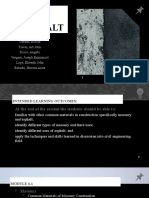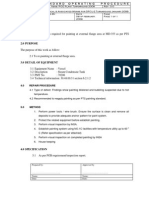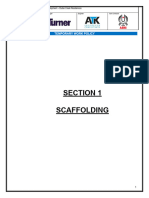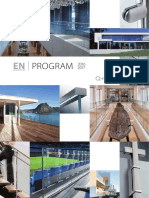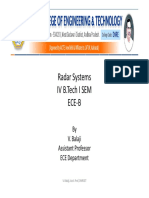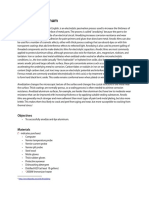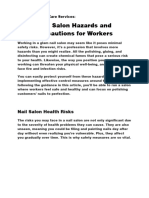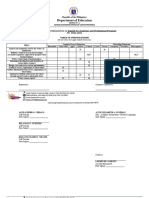Clearing Construction Site
Clearing Construction Site
Uploaded by
edwin marangeCopyright:
Available Formats
Clearing Construction Site
Clearing Construction Site
Uploaded by
edwin marangeOriginal Description:
Original Title
Copyright
Available Formats
Share this document
Did you find this document useful?
Is this content inappropriate?
Copyright:
Available Formats
Clearing Construction Site
Clearing Construction Site
Uploaded by
edwin marangeCopyright:
Available Formats
CLEARING CONSTRUCTION SITE
SECTION 110
CLEARING AND GRUBBING
110-1 Description.
Clear and grub within the areas of the roadway right-of-way and of borrow pits, sand-
clay base material pits, lateral ditches, and any other areas shown in the Plans to be cleared and
grubbed. Remove and dispose of all trees, stumps, roots and other such protruding objects,
buildings, structures, appurtenances, existing flexible asphalt pavement, and other facilities
necessary to prepare the area for the proposed construction. Remove and dispose of all product
and debris not required to be salvaged or not required to complete the construction.
Also, perform certain miscellaneous work the Engineer considers necessary for the
complete preparation of the overall project site, as follows:
1. Plug any water wells that are encountered within the right-of-way and that are
to be abandoned.
2. Level the terrain outside the limits of construction for purposes of facilitating
maintenance and other post-construction operations in accordance with 110-10.3.
3. Trim trees and shrubs within the project right-of-way that are identified in the
Contract Documents.
Meet the requirements for such miscellaneous work as specified in 110-10.
110-2 Standard Clearing and Grubbing.
110-2.1 Work Included: Completely remove and dispose of all buildings, timber, brush,
stumps, roots, rubbish, debris, and all other obstructions resting on or protruding through the
surface of the existing ground and the surface of excavated areas, and all other structures and
obstructions necessary to be removed and for which other items of the Contract do not specify
the removal thereof, including septic tanks, building foundations, and pipes.
Perform Standard Clearing and Grubbing within the following areas:
1. All areas where excavation is to be done, including borrow pits, lateral
ditches, right-of-way ditches, etc.
2. All areas where roadway embankments will be constructed.
3. All areas where structures will be constructed, including pipe culverts
and other pipe lines.
110-2.2 Depths of Removal of Roots, Stumps, and Other Debris: In all areas where
excavation is to be performed, or roadway embankments are to be constructed, remove roots and
other debris to a depth of 12 inches below the ground surface. Remove roots and other debris
from all excavated material to be used in the construction of roadway embankment or roadway
base. Plow the surface to a depth of at least 6 inches, and remove all roots thereby exposed to a
depth of at least 12 inches. Completely remove and dispose of all stumps within the roadway
right-of-way.
Remove all roots, etc., protruding through or appearing on the surface of the
completed excavation within the roadway area and for structures, to a depth of at least 12 inches
below the finished excavation surface.
Remove or cut off all stumps, roots, etc., below the surface of the completed
excavation in borrow pits, material pits, and lateral ditches.
In borrow and material pits, do not perform any clearing or grubbing within 3 feet
inside the right-of-way line.
Within all other areas where Standard Clearing and Grubbing is to be performed
remove roots and other debris projecting through or appearing on the surface of the original
ground to a depth of 12 inches below the surface, but do not plow or harrow these areas.
110-2.3 Trees to Remain: As an exception to the above provisions, where so directed by
the Engineer, trim, protect, and leave standing desirable trees within the roadway area. Trim
branches of trees extending over the area occupied by the roadway as directed, to give a clear
height of 16 feet above the roadway.
110-2.4 Boulders: Remove any boulders encountered in the roadway excavation (other
than as permitted under the provisions of 120-7.2) or found on the surface of the ground. When
approved by the Engineer place boulders in neat piles inside the right of way. The Contractor
may stockpile boulders encountered in Department-furnished borrow areas, which are not
suitable for use in the embankment construction, within the borrow area.
110-3 Selective Clearing and Grubbing.
The Contractor shall remove and dispose of all vegetation, obstructions, etc., as provided
above except that, where so elected, the Contractor may cut roots, etc., flush with the ground
surface. Completely remove and dispose of stumps. Entirely remove undergrowth except in
specific areas designated by the Engineer to remain for aesthetic purposes. Trim, protect, and
leave standing desirable trees, with the exception of such trees as the Engineer may designate to
be removed in order to facilitate right-of-way maintenance. Remove undesirable or damaged
trees as so designated by the Engineer. Perform Selective Clearing and Grubbing only in areas so
designated in the Plans.
110-4 Protection of Property Remaining in Place.
Protect and do not displace property obstructions which are to remain in place, such as
buildings, sewers, drains, water or gas pipes, conduits, poles, walls, posts, bridges, etc.
110-5 Removal of Buildings.
110-5.1 Parts to be Removed: Completely remove all parts of the buildings, including
utilities, plumbing, foundations, floors, basements, steps, connecting concrete sidewalks or other
pavement, septic tanks, and any other appurtenances, by any practical manner which is not
detrimental to other property and improvements. Remove utilities to the point of connection to
the utility authority’s cut-in. After removing the sewer connections to the point of cut-in,
construct a concrete plug at the cut-in point, as directed by the Engineer, except where the utility
owners may elect to perform their own plugging. Contact the appropriate utility companies prior
to removal of any part of the building to ensure disconnection of services.
110-5.2 Removal by Others: Where buildings within the area to be cleared and grubbed
are so specified to be removed by others, remove and dispose of any foundations, curtain walls,
concrete floors, basements or other foundation parts which might be left in place after such
removal of buildings by others.
110-6 Removal of Existing Structures.
110-6.1 Structures to be Removed: Remove and dispose of the materials from existing
structures. Remove the following:
1. those structures, or portions of structures, shown in the Plans to be removed,
2. those structures, or portions of structures, found within the limits of the area to
be cleared and grubbed, and directed by the Engineer to be removed,
3. those structures, or portion of structures, which are necessary to be removed in
order to construct new structures, and
4. other appurtenances or obstructions which may be designated in the Contract
Documents as to be included in an item of payment for the work under this Article.
Provide detailed schedule information to the Engineer 15 working days prior to
the commencement of any demolition or renovation of any structures, even if asbestos is not
found on the project, for the Engineer’s use in notifying the Department of Environmental
Protection (DEP) on DEP Form 62-257.900(1) “Notice of Asbestos Renovation or Demolition”.
110-6.2 Method of Removal:
110-6.2.1 General: Remove the structures in such a way so as to leave no
obstructions to any proposed new structures or to any waterways. Pull, cut off, or break off
pilings to the requirements of the permit or other Contract Documents, or if not specified, not
less than 2 feet below the finish ground line. In the event that the Plans indicate channel
excavation to be done by others, consider the finish ground line as the limits of such excavation.
For materials which are to remain the property of the Department or are to be salvaged for use in
temporary structures, avoid damage to such materials, and entirely remove all bolts, nails, etc.
from timbers to be so salvaged. Mark structural steel members for identification as directed.
110-6.2.2 Removal of Steel Members With Hazardous Coatings: Provide to
the Engineer for approval, a copy of the “Contractor’s Lead in Construction Compliance
Program” from the firm actually removing and disposing of these steel members before any
members are disturbed.
Vacuum power tool clean any coated steel member to bare metal as
defined by SSPC-SP11 a minimum of 4 inches either side of any area to be heated (torch cutting,
sawing, grinding, etc.) in accordance with 29 CFR 1926.354. Abrasive blasting is prohibited.
Provide air supplied respirators in accordance with 29 CFR 1926.62 and
29 CFR 1910.134.
110-6.3 Partial Removal of Bridges: On concrete bridges to be partially removed and
widened, remove concrete by manually or mechanically operated pavement breakers, by
concrete saws, by chipping hammers, or by hydro-demolition methods. Do not use explosives.
Where concrete is to be removed to neat lines, use concrete saws or hydro-demolition methods
capable of providing a reasonably uniform cleavage face. If the equipment used will not provide
a uniform cut without surface spalling, first score the outlines of the work with small trenches or
grooves. For all demolition methods, submit for review and approval of the Engineer, a
demolition plan that describes the method of removal, equipment to be used, types of rebar
splices or couplers, and method of straightening or cutting rebars. In addition, for hydro-
demolition, describe the method for control of water or slurry runoff and measures for safe
containment of concrete fragments that are thrown out by the hydro-demolition machine.
110-6.4 Authority of U.S. Coast Guard: For structures in navigable waters, when
constructing the project under authority of a U.S. Coast Guard permit, the U.S. Coast Guard may
inspect and approve the work to remove any existing structures involved therein, prior to
acceptance by the Department.
110-6.5 Asbestos Containing Materials (ACM) Not Identified Prior to the Work:
When encountering or exposing any condition indicating the presence of asbestos, cease
operations immediately in the vicinity and notify the Engineer.
Make every effort to minimize the disturbance of the ACM. Immediately provide
for the health and safety of all workers at the job site and make provisions necessary for the
health and safety of the public that may be exposed to any potentially hazardous conditions.
Provisions shall meet all applicable laws, rules or regulations covering hazardous conditions and
will be in a manner commensurate with the gravity of the conditions.
The Engineer will notify the District Contamination Assessment Coordinator who
will coordinate selecting and tasking the Department’s Asbestos Contractor or Contamination
Assessment/Remediation Contractor (CAR). Provide access to the potential contamination area.
Preliminary investigation by the Asbestos/CAR Contractor will determine the course of action
necessary for site security and the steps necessary to resolve the contamination issue.
The Asbestos/CAR Contractor will delineate the contamination areas, any staging
or holding area required. Coordinate with the Asbestos/CAR Contractor and the Engineer to
develop a work plan that will provide the Asbestos/CAR Contractor’s operations schedule with
projected completion dates for the final resolution of the contamination issue.
The Asbestos/CAR Contractor will maintain jurisdiction over activities inside any
outlined contaminated areas and any associated staging holding areas. The Asbestos/CAR
Contractor will be responsible for the health and safety of workers within the delineated areas.
Provide continuous access to these areas for the Asbestos/CAR Contractor and representatives of
regulatory or enforcement agencies having jurisdiction.
Both Contractors will use the schedule as a basis for planning the completion of
both work efforts. The Engineer may grant the Contract Time extensions according to the
provisions of 8-7.3.2.
Cooperate with the Asbestos/CAR Contractor to expedite integration of the
Asbestos/CAR Contractor’s operations into the construction project. The Prime Contractor is not
expected to engage in routine construction activities involving asbestos containing materials.
Adjustments to quantities or to Contract unit prices will be made according to work additions or
reductions on the part of the Prime Contractor in accordance with 4-3.
The Engineer will direct the Prime Contractor when operations may resume in the
affected area.
110-7 Removal of Existing Pavement.
Remove and dispose of existing rigid portland cement concrete pavement, sidewalk,
slope pavement, ditch pavement, curb, and curb and gutter etc., where shown in the Plans or
ordered by the Engineer to be removed or where required because of the construction operations.
Retaining walls, drainage structures and flexible asphalt pavement are not included in the work
under this Article.
110-8 Ownership of Materials.
Except as may be otherwise specified in the Contract Documents, the Contractor shall
take ownership of all buildings, structures, appurtenances, and other materials removed by him
and shall dispose of them in accordance with 110-9.
110-9 Disposal of Materials.
110-9.1 General: Either stack materials designated to remain the property of the
Department in neat piles within the right-of-way or load onto the Department’s vehicles.
Dispose of timber, stumps, brush, roots, rubbish, and other objectionable material
resulting from clearing and grubbing in areas and by methods meeting the applicable
requirements of all Local, State and Federal regulations. Do not block waterways by the disposal
of debris.
110-9.2 Burning Debris: Where burning of such materials is permitted, perform all such
burning in accordance with the applicable laws, ordinances, and regulations. Perform all burning
at locations where trees and shrubs adjacent to the cleared area will not be harmed.
110-9.3 Timber and Crops: The Contractor may sell any merchantable timber, fruit
trees, and crops that are cleared under the operations of clearing and grubbing for his own
benefit, subject to the provisions of 7-1.2, which may require that the timber, fruit trees, or crops
be burned at or near the site of their removal, as directed by the Engineer. The Contractor is
liable for any claims which may arise pursuant to the provisions of this Subarticle.
110-9.4 Disposal of Treated Wood: Treated wood, including that which comes from
bridge channel fender systems, must be handled and disposed of properly during removal.
Treated wood should not be cut or otherwise mechanically altered in a manner that would
generate dust or particles without proper respiratory and dermal protection. The treated wood
must be disposed of in at least a lined solid waste facility or through recycling/reuse. Treated
wood shall not be disposed by burning or placement in a construction and demolition (C&D)
debris landfill. All compensation for the cost of removal and disposal of treated wood will be
included in the Cost of Removal of Existing Structures.
110-9.5 Hazardous Materials/Waste: Handle, transport and dispose of hazardous
materials in accordance with all Local, State and Federal requirements including the following:
1. SSPC Guide 7
2. Federal Water Pollution Control Act, and
3. Resource Conservation and Recover Act (RCRA).
Accept responsibility for the collection, sampling, classification, packaging,
labeling, accumulation time, storage, manifesting, transportation, treatment and disposal of
hazardous waste, both solid and liquid. Separate all solid and liquid waste and collect all liquids
used at hygiene stations and handle as hazardous materials/waste. Obtain written approval from
the Engineer for all hazardous materials/waste stabilization methods before implementation.
Obtain an EPA/FDEP Hazardous Waste Identification Number
(EPA/FDEP ID Number) before transporting and/or disposal of any hazardous materials/waste.
List the Department as the generator of all hazardous materials/waste.
Submit the following for the Engineers’ approval before transporting, treatment or
disposal of any hazardous materials/waste:
1. Name, address and qualifications of the transporter,
2. Name, address and qualifications of the treatment facility,
3. Proposed treatment and/or disposal of all Hazardous Materials/Waste.
Transport all hazardous materials/waste in accordance with applicable
40 CFR 263 Standards. Provide a copy of all completed Hazardous Materials/Waste
manifest/bills of lading to the Engineer within 21 days of each shipment.
110-9.5.1 Steel Members With Hazardous Coating: Dispose of steel members
with hazardous coating in one of the following manners:
1. Deliver the steel members and other hazardous waste to a licensed
recycling or treatment facility capable of processing steel members with hazardous coating.
2. Deliver the steel members with hazardous coating to a site designated
by the Engineer for use as an offshore artificial reef. Deliver any other hazardous materials/waste
to a licensed hazardous materials/waste recycling treatment facility.
Dismantle and/or cut steel members to meet the required dimensions of
the recycling facility, treatment facility or offshore artificial reef agency.
All compensation for the cost of removal and disposal of hazardous
materials/waste will be included in the Cost of Removal of Existing Structures.
110-9.5.2 Certification of Compliance: Furnish two copies of Certification of
Compliance from the firm actually removing and disposing of the hazardous materials/waste
stipulating, the hazardous materials/waste has been handled, transported and disposed of in
accordance with this Specification. The Certification of Compliance shall be attested to by a
person having legal authority to bind the company.
Maintain all records required by this Specification and ensure these
records are available to the Department upon request.
110-10 Miscellaneous Operations.
110-10.1 Water Wells Required to be Plugged: Fill or plug all water wells within the
right-of-way, including areas of borrow pits and lateral ditches, that are not to remain in service,
in accordance with applicable Water Management District rules or the Department of
Environmental Protection regulations.
Cut off the casing of cased wells at least 12 inches below the ground line or
12 inches below the elevation of the finished excavation surface, whichever is lower. Water
wells, as referred to herein, are defined either as artesian or non-artesian, as follows:
1. An artesian well is an artificial hole in the ground from which water
supplies may be obtained and which penetrates any water-bearing rock, the water in which is
raised to the surface by natural flow or which rises to an elevation above the top of the water-
bearing bed. Artesian wells are further defined to include all holes drilled as a source of water
that penetrate any water-bearing beds that are a part of the artesian water system of Florida, as
determined by representatives of the applicable Water Management District.
2. A non-artesian (water-table) well is a well in which the source of water
is an unconfined aquifer. The water in a non-artesian well does not rise above the source bed.
When the Plans do not indicate whether a non-flowing well is artesian or non-
artesian, obtain this information from the Engineer.
110-10.2 Landscape Areas: When certain areas of the right-of-way, outside of the limits
of construction, are shown in the Plans or designated by the Engineer to be landscaped, either
under the construction Contract or at a later time, remove undesirable trees, stumps,
undergrowth, and vegetation, as directed, and preserve and trim natural growth and trees as
directed by the Engineer.
110-10.3 Leveling Terrain: Within the areas between the limits of construction and the
outer limits of clearing and grubbing, fill all holes and other depressions, and cut down all
mounds and ridges. Make the area of a sufficient uniform contour so that the Department’s
subsequent mowing and cutting operations are not hindered by irregularity of terrain. Perform
this work regardless of whether the irregularities were the result of construction operations or
existed originally.
110-10.4 Mailboxes: When the Contract Documents require furnishing and installing
mailboxes, permit each owner to remove the existing mailbox. Work with the Local Postmaster
to develop a method of temporary mail service for the period between removal and installation of
the new mailboxes. Install the mailboxes in accordance with the Design Standards.
110-11 Method of Measurement.
110-11.1 Clearing and Grubbing: When direct payment is provided in the Contract, the
quantity to be paid for will be the lump sum quantity.
110-11.2 Removal of Existing Structures: When direct payment is provided in the
Contract, the quantity to be paid for will be the lump sum quantity or quantities for the specific
structures removed, as designated.
110-11.3 Removal of Existing Pavement: Payment for removal of flexible asphalt
pavement is included in the Lump Sum price for Clearing and Grubbing.
No separate payment will be made for removal of curb, sidewalk, slope pavement,
or ditch pavement that is removed and replaced, as specified in 520-11, 522-9, and 524-10.
The quantity to be paid for will be the number of square yards of existing
pavement of the types listed in 110-7, acceptably removed and disposed of, as specified. The
quantity will be determined by actual measurement along the surface of the pavement before its
removal. Measurements for appurtenances which have irregular surface configurations, such as
curb and gutter, steps, and ditch pavement, will be the area as projected to an approximate
horizontal plane. Where the removal of pavement areas is necessary only for the construction of
box culverts, pipe culverts, storm sewers, inlets, manholes, etc., these areas will not be included
in the measurements.
110-11.4 Plugging Water Wells: When direct payment is provided in the Contract, the
quantity to be paid for will be the number of water wells plugged, for each type of well (artesian
or non-artesian).
110-11.5 Mailboxes: When direct payment is provided in the Contract, the quantity to be
paid for will be the number of mailboxes acceptably furnished and installed.
110-11.6 Delivery of Salvageable Material to the Department When direct payment is
provided in the Contract, the quantity to be paid for will be the Lump Sum quantity for delivery
of salvageable materials to the Department as indicated in the Plans.
110-11.7 General: In each case, except as provided below, where no item of separate
payment for such work is included in the proposal, all costs of such work will be included in the
various scheduled items in the Contract, or under specific items as specified herein below or
elsewhere in the Contract.
110-12 Basis of Payment.
110-12.1 Clearing and Grubbing:
110-12.1.1 Lump Sum Payment: Price and payment will be full compensation
for all clearing and grubbing required for the roadway right-of-way and for lateral ditches,
channel changes, or other outfall areas, and any other clearing and grubbing indicated, or
required for the construction of the entire project, including all necessary hauling, furnishing
equipment, equipment operation, furnishing any areas required for disposal of debris, leveling of
terrain and the landscaping work of trimming, etc., as specified herein, except for any areas
designated to be paid for separately or to be specifically included in the costs of other work
under the Contract.
Where construction easements are specified in the Plans and the limits of
clearing and grubbing for such easements are dependent upon the final construction
requirements, no adjustment will be made in the lump sum price and payment, either over or
under, for variations from the limits of the easement defined in the Plans.
110-12.1.2 When No Direct Payment is Provided: When no item for clearing
and grubbing is included in the proposal, the Contractor shall include the cost of any work of
clearing and grubbing which is necessary for the proper construction of the project in the
Contract price for the structure or other item of work for which such clearing and grubbing is
required.
The Contractor shall include the cost of all clearing and grubbing which
might be necessary in pits or areas from which base material is obtained in the Contract price for
the base in which such material is used. The clearing and grubbing of areas for obtaining
stabilizing materials, where required only for the purpose of obtaining materials for stabilizing,
will not be paid for separately.
110-12.2 Removal of Existing Structures: Price and payment will be full compensation
for all work of removal and disposal of the designated structures.
When direct payment for the removal of existing structures is not provided in the
proposal, the Contractor shall include the cost of removing all structures in the Contract price for
clearing and grubbing or, if no item of clearing and grubbing is included, in the compensation for
the other items covering the new structure being constructed.
110-12.3 Removal of Existing Pavement: Price and payment will be full compensation
for performing and completing all the work of removal and satisfactory disposal.
When no separate item for this work is provided and no applicable item of
excavation or embankment covering such work (as provided in 120-13.1) is included, the
Contractor shall include the costs of this work in the Contract price for the item of clearing and
grubbing or for the pipe or other structure for which the pavement removal is required.
110-12.4 Plugging Water Wells: Price and payment will be full compensation for each
type of well acceptably plugged.
If a water well requiring plugging is encountered and the Contract contains no
price for plugging wells of that specific type, the plugging of such well will be paid for as
unforeseeable work.
110-12.5 Mailboxes: Price and payment will be full compensation for all work and
materials required, including supports and numbers.
110-12.6 Delivery of Salvageable Material to the Department: Price and payment will
be full compensation for all work required for delivery of the materials to the Department.
110-12.7 Payment Items: Payment will be made under:
Item No. 110- 1- Clearing and Grubbing - lump sum.
Item No. 110- 3- Removal of Existing Structures - lump sum.
Item No. 110- 4- Removal of Existing Pavement - per square yard.
Item No. 110- 5- Plugging Water Wells (Artesian) - each.
Item No. 110- 6- Plugging Water Wells (Non-Artesian) - each.
Item No. 110- 7- Mailbox (Furnish and Install) - each.
Item No. 110- 86- Delivery of Salvageable Material to FDOT - lump sum.
You might also like
- PWC - IfrsDocument65 pagesPWC - Ifrsalmirb7No ratings yet
- KRR SemidDocument4 pagesKRR SemidKeat HongNo ratings yet
- Residential Densities HandbookDocument96 pagesResidential Densities HandbookdasaNo ratings yet
- 200 - Site ClearingDocument10 pages200 - Site Clearingruwan.smb1No ratings yet
- 128-Earthwork (Series 200)Document107 pages128-Earthwork (Series 200)Damaries Velázquez GalarzaNo ratings yet
- Example Design 1 - 6 Terrace HomesDocument18 pagesExample Design 1 - 6 Terrace HomesJuan Fernando RestrepoNo ratings yet
- Job Description: King's College King's Parade Cambridge CB2 1STDocument3 pagesJob Description: King's College King's Parade Cambridge CB2 1STsiva8000No ratings yet
- Example Design 2 - 10 Terrace HomesDocument18 pagesExample Design 2 - 10 Terrace HomesJuan Fernando RestrepoNo ratings yet
- The Masterbuilder - September 2012 - Flooring SpecialDocument224 pagesThe Masterbuilder - September 2012 - Flooring SpecialChaitanya Raj Goyal100% (1)
- Work and Its Quality Control PaintingDocument61 pagesWork and Its Quality Control PaintingElmokadem EinsteinNo ratings yet
- Taman Siniawan 2 BrochureDocument6 pagesTaman Siniawan 2 BrochureFUIYEENo ratings yet
- 2clearing & GrubbingDocument2 pages2clearing & GrubbingRyan EncomiendaNo ratings yet
- Cladding Specifications - Ifc Material SpecsDocument4 pagesCladding Specifications - Ifc Material SpecsGhayas JawedNo ratings yet
- Issue 81Document124 pagesIssue 81Chow Teck CheeNo ratings yet
- Site Design ProcessDocument6 pagesSite Design ProcessElline Ivy CalitisNo ratings yet
- Concrete QA/QC Manual Sample: Selected Pages (Not A Complete Plan)Document18 pagesConcrete QA/QC Manual Sample: Selected Pages (Not A Complete Plan)AlphaNo ratings yet
- Manual On Building ConstructionDocument380 pagesManual On Building Constructionjunevi2000No ratings yet
- Shelter Construction Guide PakistanDocument85 pagesShelter Construction Guide PakistansaifullahNo ratings yet
- SASR Norms & Standards Vol 2Document174 pagesSASR Norms & Standards Vol 2NISHANT VASU100% (2)
- Excavation Safety Precautions Trenching and Excavation Safety GuidelinesDocument6 pagesExcavation Safety Precautions Trenching and Excavation Safety GuidelinesJonathanNo ratings yet
- SMART GLASS DATA SHEET v2Document3 pagesSMART GLASS DATA SHEET v2ayham.kuwait.2018No ratings yet
- Workplace Safety and Health (General Provisions) RDocument65 pagesWorkplace Safety and Health (General Provisions) RRamesh-NairNo ratings yet
- Good Site Practice WorkmanshipDocument16 pagesGood Site Practice WorkmanshipAlphaNo ratings yet
- Construction Standards Training Course ContentDocument4 pagesConstruction Standards Training Course ContentsemajamesNo ratings yet
- Hard Landscape Brochure PDFDocument32 pagesHard Landscape Brochure PDFeromax1No ratings yet
- Public Building Maintenance PlanDocument13 pagesPublic Building Maintenance Planothmani rafaaNo ratings yet
- Amico Athletic Track & Epdm BrochureDocument24 pagesAmico Athletic Track & Epdm BrochureVENKATNo ratings yet
- MSRA - Ceiling Access Fixing and Repairing WorksDocument7 pagesMSRA - Ceiling Access Fixing and Repairing WorksharoonNo ratings yet
- 3327-Preconstruction InformationDocument12 pages3327-Preconstruction InformationKURONo ratings yet
- Masonry and AsphaltDocument106 pagesMasonry and AsphaltChelsiemea Vargas100% (1)
- GRP-SHE-GUI-011-006 Method Statement - Tree Felling and Demolition Work-Rev 01 PDFDocument9 pagesGRP-SHE-GUI-011-006 Method Statement - Tree Felling and Demolition Work-Rev 01 PDFFrancis Yaw KuttinNo ratings yet
- Steps in BuildingDocument7 pagesSteps in BuildingMonde NuylanNo ratings yet
- Series 3000 - Earthworks and Pavement Layers of Gravel or Crushed StoneDocument38 pagesSeries 3000 - Earthworks and Pavement Layers of Gravel or Crushed StoneBatenda FelixNo ratings yet
- Land Clearing ManagementDocument6 pagesLand Clearing ManagementJoel Osteen RondonuwuNo ratings yet
- 2.3 Construction Method Statement: PSBP Nw2 - Mill Green School 1Document12 pages2.3 Construction Method Statement: PSBP Nw2 - Mill Green School 1longreach717No ratings yet
- Method Statement: First Fix JoineryDocument8 pagesMethod Statement: First Fix JoineryShaijan JosephNo ratings yet
- PWD Form 203A (Rev 1 - 2010)Document69 pagesPWD Form 203A (Rev 1 - 2010)Jael Yinian100% (1)
- Advanced Methods of Building ConstructionDocument10 pagesAdvanced Methods of Building ConstructionsnehaNo ratings yet
- Sample of Painting ProcedureDocument1 pageSample of Painting Procedurezefny0% (1)
- Position of Construction SupervisorDocument11 pagesPosition of Construction SupervisorIghfigufifiNo ratings yet
- Temporary Work Policy Method Statement 12.06.2016Document84 pagesTemporary Work Policy Method Statement 12.06.2016Silajit Rony DasguptaNo ratings yet
- Cleansy Facility Management (PVT) LTDDocument8 pagesCleansy Facility Management (PVT) LTDmufassirlareefNo ratings yet
- LC SmartGlass HandbookDocument55 pagesLC SmartGlass Handbookindhu sekar100% (1)
- Building Construction Manual - BTC - Nov - 2013 - EN - 0 PDFDocument48 pagesBuilding Construction Manual - BTC - Nov - 2013 - EN - 0 PDFAndreaRebecaNo ratings yet
- Roll Up SerrandaDocument9 pagesRoll Up SerrandasizwehNo ratings yet
- wk11 EARTHWORK PDFDocument47 pageswk11 EARTHWORK PDFCutting ArtsNo ratings yet
- MS-0010 Site Furniture, Play and Fitness EquipmentDocument12 pagesMS-0010 Site Furniture, Play and Fitness EquipmentAbdul LatheefNo ratings yet
- Balustrade Q Cat 2016 2017 en Ce Neutral CDocument472 pagesBalustrade Q Cat 2016 2017 en Ce Neutral CalexmilarNo ratings yet
- BULLDOZER Bulldozer Safety TrainingDocument6 pagesBULLDOZER Bulldozer Safety TrainingJp Du Randt100% (1)
- General SpecificationDocument67 pagesGeneral Specificationroyci chlinardiNo ratings yet
- Construction MethodologyDocument19 pagesConstruction MethodologyShopmore PhilippinesNo ratings yet
- TENDER Conditions - ChimneyDocument69 pagesTENDER Conditions - ChimneyAnonymous BZlsYpRxYNo ratings yet
- ApxE BollardAssessmentDocument64 pagesApxE BollardAssessmentAnorld Walker100% (1)
- Block Work 387799Document44 pagesBlock Work 387799skrai4u100% (1)
- Part 7 Construction Management, Practices and SafetyDocument1 pagePart 7 Construction Management, Practices and SafetyYashi GargNo ratings yet
- Friend of KimDocument1 pageFriend of KimBernie QuepNo ratings yet
- 110Document8 pages110Rechell MontanoNo ratings yet
- ITEM 100 Latest 2012 (M) FinalDocument13 pagesITEM 100 Latest 2012 (M) FinalMikhail TabucalNo ratings yet
- SECTION 2 (Earthwork) (FINAL)Document58 pagesSECTION 2 (Earthwork) (FINAL)Mohammad SahmoudNo ratings yet
- Nathaniel Hamot CE 44 - B3Document22 pagesNathaniel Hamot CE 44 - B3Nathaniel Llido HamotNo ratings yet
- Thesis Chapter 2 Review of Related Literature and StudiesDocument4 pagesThesis Chapter 2 Review of Related Literature and Studieslizaschmidnaperville100% (2)
- NSE Ikeja January 2017 News LetterDocument7 pagesNSE Ikeja January 2017 News LetterbbllngNo ratings yet
- Angel Eyes How ToDocument2 pagesAngel Eyes How Toapi-3754618No ratings yet
- Unit-5 - Detection of Radar Signals in NoiseDocument39 pagesUnit-5 - Detection of Radar Signals in NoiseMani Prince100% (1)
- FitzmyerDocument18 pagesFitzmyerbajaNo ratings yet
- C 360003Document1 pageC 360003Nguyễn ThaoNo ratings yet
- Instructions For Digitrip RMS 510 Trip Unit: Instruction Leaflet I. L. 29-885DDocument20 pagesInstructions For Digitrip RMS 510 Trip Unit: Instruction Leaflet I. L. 29-885DRajeelNo ratings yet
- Seminar Report: Hyperloop TrainDocument13 pagesSeminar Report: Hyperloop TrainKishan AvmNo ratings yet
- Political Response To Capitalist Crisis Neo-Marxist Theories of The State and The Case of The New DealDocument47 pagesPolitical Response To Capitalist Crisis Neo-Marxist Theories of The State and The Case of The New DealjauncitoNo ratings yet
- Cement Kiln RefractoryDocument3 pagesCement Kiln Refractoryengr kazamNo ratings yet
- Paper Sticking To PlateDocument2 pagesPaper Sticking To PlateRocio RodriguezNo ratings yet
- Pm-Clinic Data Sheet Wa180-3L Base Information: Customer Name LocationDocument3 pagesPm-Clinic Data Sheet Wa180-3L Base Information: Customer Name LocationjulianoNo ratings yet
- The Parable of The Lost SheepDocument5 pagesThe Parable of The Lost SheepTantan ManansalaNo ratings yet
- Lab Equipment: Erlenmeyer Flask Florence FlaskDocument10 pagesLab Equipment: Erlenmeyer Flask Florence FlaskAlthea ValenzuelaNo ratings yet
- Resume - Sasi KumarDocument5 pagesResume - Sasi KumarLovely BirdNo ratings yet
- Tools of Imperialism - 720LDocument6 pagesTools of Imperialism - 720LNajwa KayyaliNo ratings yet
- Prothane Hs 4800 Series-Polyurethane Coating, Part B: MSDS NumberDocument4 pagesProthane Hs 4800 Series-Polyurethane Coating, Part B: MSDS NumberJahir GomezNo ratings yet
- Factors Influencing On Grade 12 Students Chosen Courses in Jagobiao National High School - Senior High School DepartmentDocument12 pagesFactors Influencing On Grade 12 Students Chosen Courses in Jagobiao National High School - Senior High School DepartmentBianca Marie Uypala ErquilangNo ratings yet
- Shobhit Nirwan Chemistry Class 11Document246 pagesShobhit Nirwan Chemistry Class 11KiraNo ratings yet
- Anodizing ProcedureDocument4 pagesAnodizing ProcedureGoran TesicNo ratings yet
- Lesson 6 in Nail Care ServicesDocument8 pagesLesson 6 in Nail Care ServicesLeo Nino DulceNo ratings yet
- UCSP Activity 1Document3 pagesUCSP Activity 1Rudy AbeloNo ratings yet
- EAS Recommended Practices - Agile ContractingDocument79 pagesEAS Recommended Practices - Agile ContractingJustNo ratings yet
- Mini Project 2 HyperloopDocument26 pagesMini Project 2 HyperloopSushil SrivastavaNo ratings yet
- The Grenz Zone: Ossama Abbas, MD, and Meera Mahalingam, MD, PHD, FrcpathDocument9 pagesThe Grenz Zone: Ossama Abbas, MD, and Meera Mahalingam, MD, PHD, FrcpathDaniel FilizzolaNo ratings yet
- Chinese Cinderella Word FileDocument3 pagesChinese Cinderella Word Fileeric espinaNo ratings yet
- Tos - Solo Taxonomy Eapp Q2Document2 pagesTos - Solo Taxonomy Eapp Q2roxannemarie.vidamoNo ratings yet
- Tyres ReportDocument27 pagesTyres ReportSrinivasBejjamNo ratings yet
- Bike Turning Indicator Device ProjectDocument15 pagesBike Turning Indicator Device Projectomaditya993No ratings yet
- Civil Service Commission Professional or Sub DwawdawdawdreviewerDocument99 pagesCivil Service Commission Professional or Sub DwawdawdawdreviewerHarey PatarNo ratings yet





























